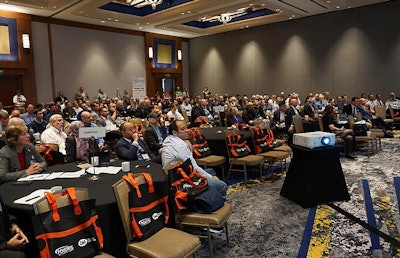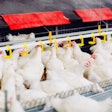
The first-ever Poultry Tech Summit brought together tech innovators, venture capitalists and poultry companies from 20 countries to triangulate on the next generation of technology that will solve problems and open new opportunities in poultry production.
Poultry Tech Summit, a WATT Global Media event, was held November 5-7, 2018, in Atlanta.
Inventor-entrepreneurs pitched innovations ranging from robots that patrol poultry houses to more mundane problem solvers like rust-proof gearboxes for the poultry processing plant. From live production to processing and all through the supply chain, every facet of the poultry business is touched by the innovations presented at Poultry Tech Summit.

Karen Christensen, Tyson Foods; Blake Patton, Tech Square Ventures; and Gary McMurray, Georgia Tech Research Institute question innovators in the robotics and automation session. | Photo by Gary Thornton
Robotics and automation
Robotics and automation generated intense interest for their potential to reduce labor, be on duty 24/7 and report remotely.
1. Gohbot, the poultry house robot that navigates poultry house floors using imaging sensors and machine learning, has the capability to detect and pick up floor eggs and sense environmental temperatures, gasses and light levels. Developers at Georgia Tech Research Institute project overall cost under $6,000.
2. ChickenBoy, an autonomous ceiling-suspended robot incorporating artificial intelligence and sensors, assesses ambient conditions, health and welfare and equipment failures. Already on the market in Europe, developers at Farm Robotics and Automation SL planning to continue adding capabilities including removal of dead birds and analysis of litter moisture.

Heiner Lehr, Farm Robotics and Automation SL, presented a ceiling-suspended poultry house robot which has sensors for monitoring bird and house conditions. | Photo by Gary Thornton
3. Woody Breast Detection with machine vision and high-speed cameras is capable of detecting and/or sorting breast fillets at normal line speeds without contacting or damaging fillets. Muscle rigidity is measured as the fillets move on and fall off a conveyor. USDA ARS developers say the system could be ready for market in one to two years.
4. 3D Bird Deboning Cutting Virtual Reality generates cutting trajectories for automated poultry processing systems. It is under development at Georgia Tech Research Institute. Testing started with models but now is on real birds.
Food safety
Food safety is a critical concern in the poultry business, and the innovations at the Summit addressed both the live production and processing stages.
5. Technicon Composite-housing Gearboxes with steel endoskeletons eliminate rust, dissipate heat and withstand wash-down processes. Housings are corrosion-resistant and blended with an antimicrobial material that does not exhibit odor or staining in harsh environments. Market launch is perhaps two years away, and prices of the composite gearboxes are expected to be competitive with units with painted cast-iron housings.
6. Clear Labs Next Generation Sequencing uses advanced data analytics and bioinformatics tools for detection and serotype identification of Salmonella spp. in samples taken from carcass rinses, ground poultry, poultry parts, boot swabs and equipment swabs. The system’s accuracy reduces inventory holding time and delayed shipments, confirmation costs and delays, and retail short-supply penalties.
7. General Probiotics Antimicrobial Probiotics are genetically modified microbes for use in the feed or water of poultry that can detect pathogens and secrete antimicrobials against pathogens, secrete multiple antimicrobials lowering resistance emergence and/or secrete engineered antimicrobial lysins. Prototypes against Salmonella, Campylobacter and Clostridia have been developed. The company expects to complete regulatory requirements and bring the products to market within three years.
Big data and artificial intelligence
Harnessing the increasing amounts and complexity of data available to the poultry enterprise is not only a daunting task but a huge opportunity. So it’s fitting that five innovations (more than in any other category) addressed this challenge.
8. Little Bird Feed Cast System estimates the amount of feed in on-farm bins using a small device to apply vibration to the bin surface along with sensors and software. The solar-powered units wirelessly report feed levels via web portals and a mobile app to growers, feed mills and integrators. The web portal presents a history of a house’s feed levels and displays projections. Feed outages are reduced or eliminated and less feed is reclaimed at the end of a flock.
9. PRYSSM (Poultry System Simulation Model) simulates the water, energy, wastewater and labor utilization of a poultry processing plant. Based on VENSIM [http://vensim.com/vensim-software/] software, the model simulates all processes that require water use. Designed by developers at Georgia Tech Research Institute as a decision making tool with predictive capabilities, there are modules for labor, water, energy and wastewater processes.
10. SDSS Multitier Statistical Process Control (SPC) uses machine learning and historical location-based data as well as plant-level outcomes to dynamically model the live operations supply chain, predict outcomes and apply outcome scores. It allows quicker and more accurate identification and response to potential changes in variables that impact food safety or production outcomes throughout the poultry supply chain.
11. Simple Vet Regulatory Compliance Data Management applies blockchain technology to veterinary records to maintain transparency and traceability while also providing analytics to evaluate efficacy of treatments. A suite of integration tools integrate data sources, including public and private blockchains, traditional databases and systems and internet-of-things (IoT) enabled devices such as RFID tags and remote sensing technology.
12. AbuErdan Poultry Value Chain Management uses predictive analytics and deep learning analysis to display KPIs and forecast future performance throughout the supply chain. An integrated view of operational data allows finished product to be traced back through the value chain at a minute level of detail. The cloud-based platform uses blockchain technology and deep learning neural networks to monitor poultry operations at large scale and across regions.
Life sciences
13. Mazen Animal Health Edible Vaccines enable chicken producers to dose room-temperature stable vaccine in the feed for both mucosal (in the gut) and systemic (intracellular) protection against coccidiosis. The technology platform inserts genes for specific antigens into corn plants to create the vaccines. The developers are seeking $5 million to $6 million in funding, which they say would allow the technology to be on the market within four years.
14. TyraTech Phytogenic Blends for Coccidiosis Control chemically block receptors specific to parasites and physically disrupt the parasite cuticle. The blends are composed of GRAS-listed terpenes that naturally occur in food plants known to be safe as food flavorants. Using a proprietary encapsulation technology, the formulation will be active in the intestine of the chicken.
15. Transport Genie records micro-climate conditions of live poultry during transport, including real-time communications with the driver and key stakeholders. If a threshold is exceeded, an alert is sent automatically. The sensor can be used by processors to improve bird welfare during the loadout, in transport and in plant holding sheds.
16. eggXYT CRISPR Gene Editing Technology inserts a bio-marker in the DNA of male chicks at the parent stock level to create an optical signature in embryos detectable at the breeding/hatching operation. Upon scanning of incoming eggs, those with male embryos are diverted to food production. A pilot study in a poultry layer flock is planned for late 2018. Developers are said to be in negotiations to incorporate the technology in the stock of a major breeding company.
Nanotechnology for virus detection
In what is the 17th innovation, the Poultry Tech Summit attendees also learned about a nanotube device under development by Virlock Technologies LLC that can trap avian flu viruses for early detection.
Mauricio Terrones, professor of physics, chemistry and materials sciences, Penn State University, described the innovation during his speech, “Nanotechnology and its impact on biotech.” The device is able to selectively trap and concentrate viruses by their size.


















